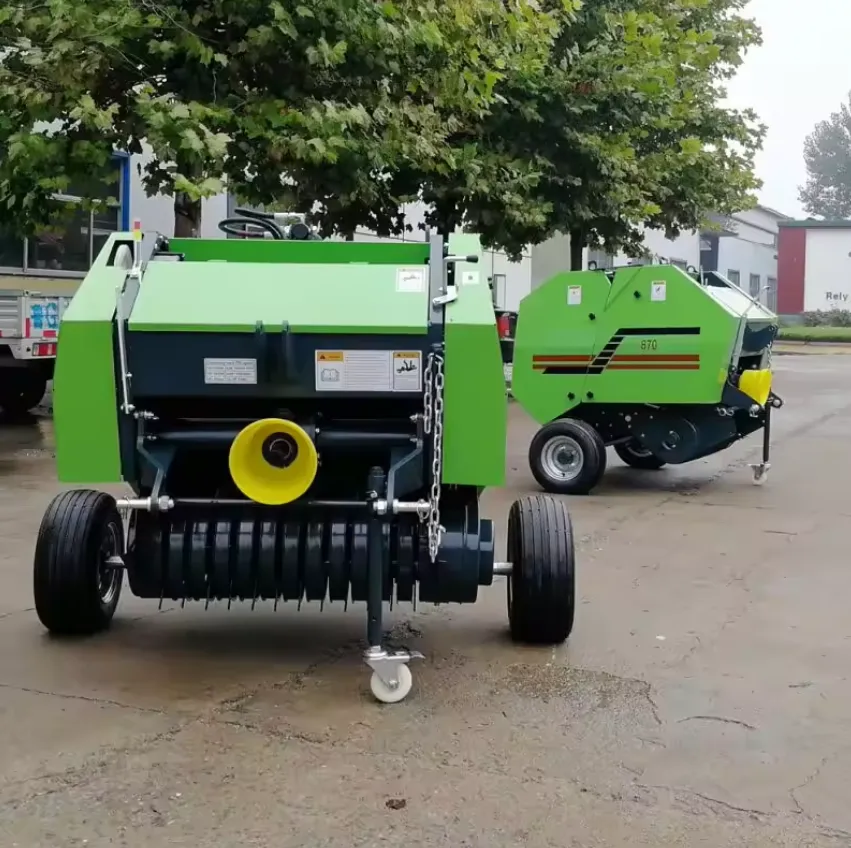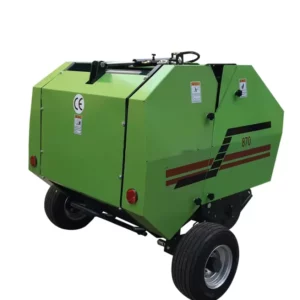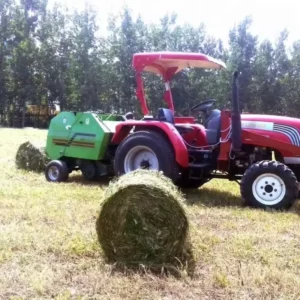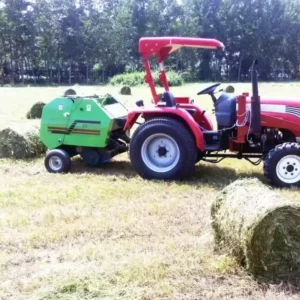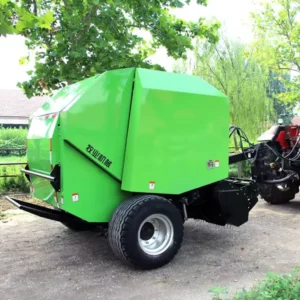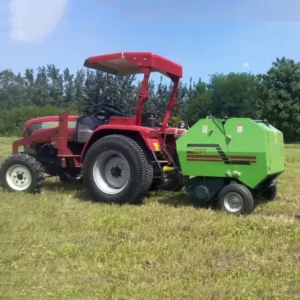The hay baler machine is a vital piece of agricultural equipment that has revolutionized the farming industry. This robust machine is ideally suited for farming applications and is designed to last. It comes with a one-year warranty on core components, including Bearing and Gear. The machine is brand new and is suitable for baling a wide range of materials such as grass, alfalfa, wheat, and rice straw. It measures 1300x1300x1350mm and weighs 425 KG.
Key Features and Benefits of the Hay Baler Machine
The hay baler machine comes packed with various key selling points that ensure a long service life. Here are six of the standout features:
- Quality Construction: The machine is built with top-notch components, ensuring durability and longevity.
- Efficient Performance: It comes with a matched power of 20-50HP, enabling it to perform efficiently and effectively.
- Wide Pickup Width: With an 80cm pickup width, the machine can gather a large amount of material in a single pass.
- Versatility: It is suitable for a variety of applications, including grass, alfalfa, wheat, and rice straw.
- Compact and Lightweight: Its compact dimensions and light weight make it easy to use and maneuver.
- Attractive Design: The machine comes in a vibrant green color, adding an aesthetic appeal to its robust features.
Applications of the Hay Baler Machine
The hay baler machine can be used in a wide range of applications. Here are six of the most common uses:
- Farming: It is ideal for use on farms for baling hay, grass, and other crops.
- Livestock Feeding: It can be used to make bales of hay for feeding livestock.
- Landscaping: The machine can be used to gather and bale cut grass for easy disposal or composting.
- Industrial Use: Some industries use hay balers for baling and recycling materials such as paper, cardboard, and plastics.
- Waste Management: The machine can be used to compact and bale waste materials for more efficient disposal or recycling.
- Construction: It can be used to bale straw for use in construction, such as straw-bale houses.

Tractor Mounted Mini Hay Round Baler Working Principle
The working principle of a tractor-mounted mini hay round baler involves several key steps to efficiently collect, compress, and bind hay or straw into compact cylindrical bales. Here is a general overview of the process:
- Attachment to Tractor: The mini hay round baler is attached to the tractor's three-point hitch or mounted on the rear of the tractor using appropriate brackets. It is typically powered by the tractor's power take-off (PTO) system, which provides the necessary rotational power.
- Pick-Up Mechanism: The baler is equipped with a pick-up mechanism at the front, which consists of a series of tines or belts. As the tractor moves forward, the pick-up mechanism collects the loose hay or straw from the ground and transfers it to the baling chamber.
- Feeding and Compression: The hay or straw is fed into the baling chamber through the pick-up mechanism. Inside the baling chamber, there is a rotating drum or rotor with spiral-shaped vanes or belts. The material is fed into the space between the rotor and the chamber wall, where it is rolled and compressed.
- Formation of Bale: As the material is continuously fed into the baling chamber, the rotating drum or rotor compresses it, gradually forming a cylindrical shape. The chamber is designed with adjustable side plates or rollers to control the size and density of the bale.
- Binding Process: Once the desired size of the bale is reached, the mini hay round baler initiates the binding process. It typically uses twine or netting to secure the bale. The twine or netting is automatically fed into the baler, and it wraps around the bale in a crisscross pattern to hold it together.
- Bale Ejection: Once the baling and binding process is complete, the mini hay round baler ejects the finished bale. It can be released onto the ground or onto a bale wagon or trailer attached to the rear of the baler. Some balers also have a hydraulic ejection system that pushes the bale out of the chamber.
- Repeat Process: After the bale is ejected, the mini hay round baler is ready to repeat the process for the next bale. The pick-up mechanism continues to collect the hay or straw, and the cycle of feeding, compression, binding, and ejection is repeated until the desired number of bales is produced.

How to Install the Mini Hay Round Baler to a Tractor
Installing a mini hay round baler to a tractor involves a few key steps to ensure proper attachment and secure operation. Here is a general guide on how to install a mini hay round baler to a tractor:
- Check Compatibility: Before installing the baler, ensure that it is compatible with your tractor. Check the specifications and requirements provided by the baler manufacturer to ensure it can be safely attached to your tractor's three-point hitch or mounting brackets.
- Position the Tractor: Park the tractor on a level surface and engage the parking brake. Ensure that the tractor is turned off and the PTO is disengaged.
- Align the Baler: Position the mini hay round baler behind the tractor, aligning it with the three-point hitch or mounting brackets. Ensure that the baler's hitch or brackets are at the correct height for attachment.

- Attach the Lower Linkage: Lower the three-point hitch of the tractor to align the lower linkage arms with the baler's hitch or brackets. Insert the lower linkage pins through the appropriate holes on both sides and secure them with the locking devices provided.
- Attach the Top Link: Connect the top link of the tractor to the baler's top link bracket. Adjust the length of the top link to ensure proper alignment and maintain the desired working position of the baler. Double-check that all attachment points are securely fastened and locked. Ensure that there is no excessive play or movement between the tractor and the baler.
- Connect the PTO Shaft: Locate the PTO shaft on the baler and align it with the PTO output shaft on the tractor. Slide the PTO shaft onto the tractor's PTO shaft, ensuring that the splines engage properly. Secure the PTO shaft with the provided safety chain or locking mechanism.
- Test Operation: Start the tractor and engage the PTO. Observe the rotation of the baler's components to ensure smooth operation. Check for any unusual noises or vibrations that may indicate improper installation or alignment.
Common Troubleshooting of the Hay Baler Machine
Troubleshooting common issues with a tractor-mounted mini hay round baler involves identifying and addressing problems that can affect its performance and the quality of the bales produced. Here are some frequent issues encountered with these balers and potential solutions:
- Baler Not Starting or Operating: This could be due to PTO connection issues, insufficient hydraulic pressure, or electrical faults. Ensure the PTO shaft is correctly connected and that the tractor's PTO output matches the baler's requirements. Check the hydraulic system for leaks or low pressure and repair as necessary. Inspect electrical connections and fuses for faults.
- Uneven or Loose Bales: This could be due to incorrect tension settings, uneven windrow feeding, or worn parts. Adjust the baler's tension settings according to the manufacturer's instructions. Ensure even and consistent feeding of the windrow into the baler. Replace any worn belts, rollers, or other parts affecting bale formation.

- Baler Jamming or Clogging: This could be due to overfeeding, wet or overly dry material, or mechanical obstructions. Feed the material at a consistent rate to avoid overloading the baler. Avoid baling excessively wet or dry material. Clear any obstructions in the baler's intake or mechanism.
- Bales Not Tying or Wrapping Properly: This could be due to twine or net wrap issues, malfunctioning tying or wrapping mechanism, or incorrect settings. Check and refill twine or net wrap supplies. Inspect the tying or wrapping mechanism for damage or malfunctions and repair or adjust as necessary. Ensure settings for tying or wrapping are correctly configured.
- Excessive Wear or Damage to Baler Components: This could be due to lack of maintenance, incorrect settings, or operating beyond capacity. Regularly inspect and maintain the baler, including lubrication and part replacements. Adjust settings to match the operating conditions and material being baled. Avoid operating the baler beyond its designed capacity.
- Poor Baler Performance or Efficiency: This could be due to incorrect tractor-baler setup, improper PTO speed, or baler not leveled. Ensure the baler is correctly attached and leveled on the tractor. Adjust the PTO speed to match the baler's requirements. Check that the baler is properly configured for the tractor's capabilities.
Why Choose AGKNX's Mini Hay Round Baler?
AGKNX Agricultural Machinery Co., Ltd. is renowned for its high-quality agricultural machinery, including the mini hay round baler. Here's why you should consider their products:
- Expertise: AGKNX has been in the agricultural machinery business since 1989, offering over 30 years of experience and knowledge.
- Quality: All products are made with high-quality materials and are built to last, ensuring you get the most out of your investment.
- Customization: AGKNX offers a wide range of products and can customize the machinery to suit your specific needs.
- Certifications: The company holds international certifications, ensuring their products meet global standards of quality and safety.
- After-Sales Service: AGKNX provides excellent after-sales service, including maintenance and repair, ensuring your machinery continues to perform at its best.


Introduction to AGKNX
Established in 1989, AGKNX Agricultural Machinery Co., Ltd. is a leading manufacturer of agricultural machinery. The company boasts an experienced technical staff, including five senior R&D personnel, and a strong production technology. AGKNX utilizes advanced equipment such as lathing, milling, planing, stamping, cutting plate, and electric welding. The company also uses a CAD computer-aided design system, ensuring precision in their manufacturing process.
AGKNX's products are sold all over the country and are exported to many countries and regions in Europe, America, Africa, the Middle East, and Southeast Asia all year round. This global reach is a testament to the quality and reliability of their products.
Video Overview of the Hay Baler Machine
For a more detailed overview of the hay baler machine, watch the video below:

